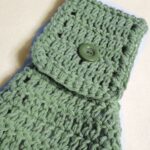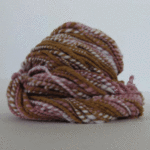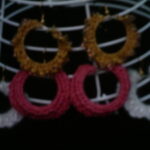So you’re ready to learn to knit or crochet and you know that the first step is to pick out some yarn to start practicing with. As you go to your local yarn store you notice that there are so many different types of yarn, all made with different fibers – what should you choose? What are the differences between wool, cotton and acrylic yarns?
You can find out what a yarn is made out of by looking at the ball band. Often times yarn will be a mix of fibers, in which case it will have a mix of characteristics.
In all but the most high-end yarn stores, the most popular type of yarn you will come across will be acrylic yarn. Acrylic yarn is made from thinly spun plastic, and therefore it can be very inexpensive. Some cheaper acrylic yarns will feel stiff and scratchy, while others may feel indistinguishable from wool yarn. Acrylic yarns do not “breathe” as well as wool or cotton yarn, so clothing made from acrylic yarns may make the wearer sweaty and uncomfortable. Acrylic yarns are often looked down upon by many experienced knitters not only because they do not breathe as well as their counterparts but the drape and flow of fabric from acrylic yarn is not usually as nice as fabric from natural fibered yarns. Other knitters consider acrylic yarns superior to cotton or wool because it is easy to care for items made with acrylic yarns, as they can be put into the washing machine and dryer without worry. Wool and cotton yarns are also subject to differences between dye lots meaning there may be slight variations in colors between one batch of yarn to the next, which causes problems if a knitter runs out of yarn mid sweater and can’t find more yarn from the same dye lot. Acrylic yarns have no dye lots and are always the same color.
Cotton yarn is made from fibers from the cotton plant. Cotton creates a very breathable fabric and is therefore suggested for summer knitting. Yet strangely although it is recommended for summer knits because of its breathability, cotton yarn does create a very heavy fabric. Often times cotton fibers are mixed with wool to create a breathable yet light fabric. Cotton mixes make excellent socks and summer clothing. 100% cotton yarn can be difficult to work with because it does not have a lot of spring or stretch to it, which is another reason why cotton is often mixed with wool. Cotton creates a very absorbent fabric, and therefore 100% cotton yarn is used to make kitchen dishcloths or tea towels. Cotton yarn can be washed by machine and dryer, but it may shrink. Also, if a cotton yarn is mixed with wool it may no longer be machine washable, depending on the type of wool it is mixed with. Look at the ball band on your yarn for care instructions.
Wool yarn is made from fiber that come from animals. This includes not only sheep, but also goats, alpaca, rabbits, or any other animal that provides fiber that can be spun. Wool from different animals will create yarn with different characteristics, but all wool has some common characteristics. Wool is very warm, breathes well, and creates a light fabric. Wool yarn creates fantastic socks and warm weather clothing such as hats, scarves and sweaters. Perhaps the most problematic characteristic of wool is its tendency to “felt” or “full.” Felting occurs when wool fibers are exposed to hot water and are agitated (such as what happens in a washing machine), and the result is wool fibers melding together to create a fabric that resembles a piece of felt (this is, in fact, how felt is made, except it is done with unspun wool fibers rather than yarn). Sometimes a knitter will purposely felt projects to create a certain look, but unwanted felting will certainly destroy a garment. Therefore wool is difficult to care for; often times wool may be combined with acrylic or cotton yarns that will make it more resistant to felting. There is also “superwash” wool, which is wool that has been treated in a way that makes it safe to put in the washing machine and dryer with little risk of felting. And remember, wool does not have to be itchy! There are plenty of different types of wool available, some of which is extremely soft and light.
When choosing yarn it is best to consider what you want in a finish product. What type of garment are you knitting? Are you looking for an easily cared for garment? And what kind of weather will you be wearing your knitted garments in?
Keep in mind that this is not a complete list of all the different types of yarn you may encounter, just the most popular!






